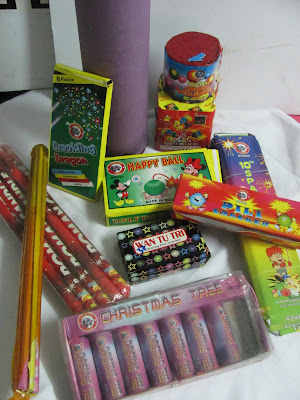EcoWaste Coalition Raises Concern over Toxic Pollution from Firecrackers and Fireworks

Is the toxic cocktail worth the colorful and dazzling show?
The EcoWaste Coalition, a toxics watchdog, raised this question after finding significant quantities of metallic elements in all the 11 firecrackers bought from street vendors in Divisoria, Manila.
Using a handheld device called the X-Ray Fluorescence (XRF) analyzer, the EcoWaste Coalition detected arsenic, barium, cadmium, chromium, copper, lead, manganese and zinc, which are used to create sparkles and colors in pyrotechnics.
On the average, each firecracker sample contains 3 to 6 of these metals that are added to the black powder mixture of charcoal, sulfur, potassium or sodium nitrate.
Among the samples, “Sparklers,” which sells for 20 pesos per box, was found to contain the highest levels of barium at 25,000 ppm, 2,935 ppm of zinc, 1,874 of manganese, 807 ppm of chromium and 17 ppm of arsenic.
A “Pili Cracker,” which costs 25 pesos per pack, had 5,126 of lead and 1,492 ppm of copper, while a “Christmas Tree” had 195 ppm of cadmium.
“We are very concerned about the health effects of these crackers and sparklers many of which are held by hands or lighted near users who directly breathe the toxic fumes,” said Aileen Lucero, Iwas PapuToxic Campaigner, EcoWaste Coalition.
“It’s even hard to imagine the toxic cocktail created from the simultaneous blasting of huge quantities of firecrackers and fireworks during the countdown to the New Year, especially in urban areas,” she added.
“In fact, the chemical smog can persist for hours if not days after the revelry turning the atmosphere into a virtual gas chamber. This is especially hazardous for infants and children, pregnant women and people suffering from chronic asthma,” she pointed out.
According to a recent advisory by the Department of Health, “people in the cities already inhale significant amounts of contaminant particles stemming from industrial, traffic and cigarette emissions, and the dense smoke caused by fireworks may aggravate their health conditions.”
The Department of Environment had earlier said that pollutants from firecrackers and pyrotechnics lead to the formation of greenhouse gases such as carbon dioxide, carbon monoxide and nitrogen dioxide.
Environment Secretary Ramon J.P. Paje had warned that the pollution would also slow down the gains in improving the air quality, particularly in Metro Manila, where the level of total suspended particulates (TSPs) declined during the first three quarters of 2011.
Based on DENR’s monitoring, TSPs decreased from 130 ug/ncm to 120 ug/ncm in the third quarter of 2011 compared to the same period of 2010.
Knowing the adverse impacts to health, environment and climate, the EcoWaste Coalition has renewed its call for an emission-free and injury-proof New Year celebrations sans firecrackers and fireworks.
The group had earlier sought a critical review of Republic Act 7183, the law regulating firecrackers and pyrotechnic devices, to make it in full harmony with the country’s environmental laws such as the Clean Air Act, Clean Water Act and the Ecological Solid Waste Management Act.
-end-





Comments